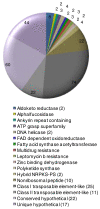A first genome assembly of the barley fungal pathogen Pyrenophora teres f. teres
- PMID: 21067574
- PMCID: PMC3156948
- DOI: 10.1186/gb-2010-11-11-r109
A first genome assembly of the barley fungal pathogen Pyrenophora teres f. teres
Abstract
Background: Pyrenophora teres f. teres is a necrotrophic fungal pathogen and the cause of one of barley's most important diseases, net form of net blotch. Here we report the first genome assembly for this species based solely on short Solexa sequencing reads of isolate 0-1. The assembly was validated by comparison to BAC sequences, ESTs, orthologous genes and by PCR, and complemented by cytogenetic karyotyping and the first genome-wide genetic map for P. teres f. teres.
Results: The total assembly was 41.95 Mbp and contains 11,799 gene models of 50 amino acids or more. Comparison against two sequenced BACs showed that complex regions with a high GC content assembled effectively. Electrophoretic karyotyping showed distinct chromosomal polymorphisms between isolates 0-1 and 15A, and cytological karyotyping confirmed the presence of at least nine chromosomes. The genetic map spans 2477.7 cM and is composed of 243 markers in 25 linkage groups, and incorporates simple sequence repeat markers developed from the assembly. Among predicted genes, non-ribosomal peptide synthetases and efflux pumps in particular appear to have undergone a P. teres f. teres-specific expansion of non-orthologous gene families.
Conclusions: This study demonstrates that paired-end Solexa sequencing can successfully capture coding regions of a filamentous fungal genome. The assembly contains a plethora of predicted genes that have been implicated in a necrotrophic lifestyle and pathogenicity and presents a significant resource for examining the bases for P. teres f. teres pathogenicity.
© 2010 Ellwood et al.; licensee BioMed Central Ltd.
Figures






Similar articles
-
Reference Assembly and Annotation of the Pyrenophora teres f. teres Isolate 0-1.G3 (Bethesda). 2018 Jan 4;8(1):1-8. doi: 10.1534/g3.117.300196. G3 (Bethesda). 2018. PMID: 29167271 Free PMC article.
-
Evaluation of a Pyrenophora teres f. teres mapping population reveals multiple independent interactions with a region of barley chromosome 6H.Fungal Genet Biol. 2014 Sep;70:104-12. doi: 10.1016/j.fgb.2014.07.012. Epub 2014 Aug 2. Fungal Genet Biol. 2014. PMID: 25093269
-
Pyrenophora teres: profile of an increasingly damaging barley pathogen.Mol Plant Pathol. 2011 Jan;12(1):1-19. doi: 10.1111/j.1364-3703.2010.00649.x. Mol Plant Pathol. 2011. PMID: 21118345 Free PMC article. Review.
-
Genetic analysis of virulence in the Pyrenophora teres f. teres population BB25×FGOH04Ptt-21.Fungal Genet Biol. 2017 Oct;107:12-19. doi: 10.1016/j.fgb.2017.07.003. Epub 2017 Jul 17. Fungal Genet Biol. 2017. PMID: 28728987
-
Research advances in the Pyrenophora teres-barley interaction.Mol Plant Pathol. 2020 Feb;21(2):272-288. doi: 10.1111/mpp.12896. Epub 2019 Dec 13. Mol Plant Pathol. 2020. PMID: 31837102 Free PMC article. Review.
Cited by
-
Endophytic fungi from kale (Brassica oleracea var. acephala) modify roots-glucosinolate profile and promote plant growth in cultivated Brassica species. First description of Pyrenophora gallaeciana.Front Microbiol. 2022 Oct 5;13:981507. doi: 10.3389/fmicb.2022.981507. eCollection 2022. Front Microbiol. 2022. PMID: 36274741 Free PMC article.
-
Genomic Analysis of Genes Involved in the Biosynthesis of Very Long Chain Polyunsaturated Fatty Acids in Thraustochytrium sp. 26185.Lipids. 2016 Sep;51(9):1065-75. doi: 10.1007/s11745-016-4181-6. Epub 2016 Aug 11. Lipids. 2016. PMID: 27514858
-
The First Telomere-to-Telomere Chromosome-Level Genome Assembly of Stagonospora tainanensis Causing Sugarcane Leaf Blight.J Fungi (Basel). 2022 Oct 16;8(10):1088. doi: 10.3390/jof8101088. J Fungi (Basel). 2022. PMID: 36294653 Free PMC article.
-
IMA genome‑F17 : Draft genome sequences of an Armillaria species from Zimbabwe, Ceratocystis colombiana, Elsinoë necatrix, Rosellinia necatrix, two genomes of Sclerotinia minor, short‑read genome assemblies and annotations of four Pyrenophora teres isolates from barley grass, and a long-read genome assembly of Cercospora zeina.IMA Fungus. 2022 Nov 21;13(1):19. doi: 10.1186/s43008-022-00104-3. IMA Fungus. 2022. PMID: 36411457 Free PMC article. No abstract available.
-
Genome Analyses of Two Blueberry Pathogens: Diaportheamygdali CAA958 and Diaporthe eres CBS 160.32.J Fungi (Basel). 2022 Jul 29;8(8):804. doi: 10.3390/jof8080804. J Fungi (Basel). 2022. PMID: 36012791 Free PMC article.
References
-
- Mathre DE. Compendium of Barley Diseases. 2. St Paul MN, American Phytopathological Society; 1997.
-
- Murray GM, Brennan JP. Estimating disease losses to the Australian barley industry. Aust Plant Pathol. 2010;39:85–96.
-
- Smedegård-Petersen V. Pyrenophora teres f. maculata f. nov. and Pyrenophora teres f. teres on barley in Denmark. Kgl Vet Landbohojsk Arsskr. 1971. pp. 124–144.
-
- Rau D, Attene G, Brown A, Nanni L, Maier F, Balmas V, Saba E, Schäfer W, Papa R. Phylogeny and evolution of mating-type genes from Pyrenophora teres, the causal agent of barley 'net blotch' disease. Curr Genet. 2007;51:377–392. - PubMed
-
- Campbell GF, Lucas JA, Crous PW. Evidence of recombination between net- and spot-type populations of Pyrenophora teres as determined by RAPD analysis. Mycol Res. 2002;106:602–608.
Publication types
MeSH terms
Substances
LinkOut - more resources
Full Text Sources
Other Literature Sources
Molecular Biology Databases
Miscellaneous

